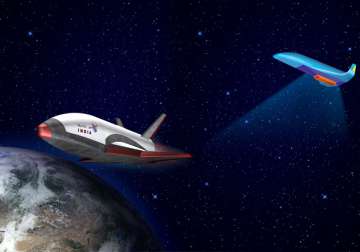10 facts to know about India’s first reusable space shuttle (RLV-TD)
India today successfully launched the first technology demonstrator of indigenously made Reusable Launch Vehicle (RLV). The ‘dummy’ RLV was launched from Sriharikota in Andhra Pradesh into the orbit around Earth, and then glided back onto a virtual r
New Delhi: India today successfully launched the first technology demonstrator of indigenously made Reusable Launch Vehicle (RLV). The ‘dummy’ RLV was launched from Sriharikota in Andhra Pradesh into the orbit around Earth, and then glided back onto a virtual runway in the Bay of Bengal, some 500 kilometres from the coast.
"Mission accomplished successfully," an Indian Space Research Organisation (ISRO) spokesman said soon after RLV-TD HEX-01 was flight tested with the take off at 7 am.
The 6.5 m long 'aeroplane'-like structure weighs 1.75 tonnes and was hoisted into the atmosphere on the special rocket booster.
This is the first time ISRO has launched a winged flight vehicle, which glided back onto a virtual runway in the Bay of Bengal, some 500 kilometres from the coast.
Here is the list of 10 facts you should know about the reusable space shuttle:
1. RLV, being dubbed as India's own space shuttle, is the unanimous solution to achieve low cost, reliable and on-demand space access. It will reduce the cost of manufacturing infrastructure in space by 10 times.
2. RLV-TD is a series of technology demonstration missions that have been considered as a first step towards realising a Two Stage To Orbit (TSTO) fully re-usable vehicle.
3. It has been configured to act as a flying testbed to evaluate various technologies, including hypersonic flight, autonomous landing, powered cruise flight and hypersonic flight using air-breathing propulsion.
4. The first experiment conducted was the hypersonic flight experiment, and the entire mission was around 10 minutes from liftoff to splashdown. The vehicle, however, will not be recovered, as it was a ‘dummy’. The RLV-TD is described as "a very preliminary step" in the development of a reusable rocket, whose final version is expected to take in 10 to 15 years.
5. ISRO said that the first in the series of experimental flights is the hypersonic flight experiment (HEX) followed by the landing experiment (LEX), return flight experiment (REX) and scramjet propulsion experiment (SPEX). “In subsequent test flights, we will attempt to land the reusable vehicle at a specific location on land like an aircraft does on a runway so that we can again use it for launching more satellites,” Vikram Sarabhai Space Centre (VSSC) director K Sivan said.
6. The cost of developing the RLV technology is estimated to be about Rs 100 crore ($15 million). The space agency’s telemetry, tracking and command network (Istrac) in Bangalore will collect the data from the vehicle.
7. India’s Space Shuttle programme is the not first in the world. NASA used to have its own space shuttle programme with shuttles like Enterprise, Discovery, Endeavor, Columbia, Atlantis and Challenger. They were seen as a space transportation system for over three decades from 1981 to 2011, when NASA finally ended the programme.
8. No other country is currently operationally flying a winged spacecraft into space - the US retired its space shuttles in 2011 and the Russians flew theirs only once in 1989.
9. ISRO plans to test two more such prototypes before the final version which will be about six times larger at around 40 metres and will take off around 2030.
10. The manufacturing of RLV-TD started more than 10 years ago at the Vikram Sarabhai Space Centre (VSSC) in Thiruvananthapuram. On its website, the ISRO explains: “It has been configured to act as a flying test bed to evaluate various technologies, namely, hypersonic flight, autonomous landing, powered cruise flight and hypersonic flight using air-breathing propulsion."
